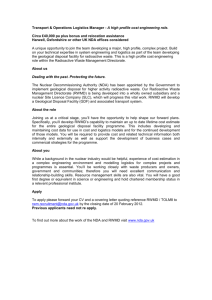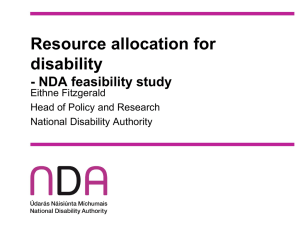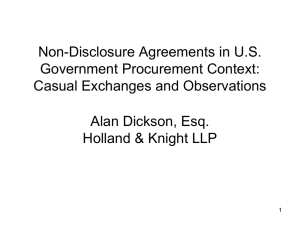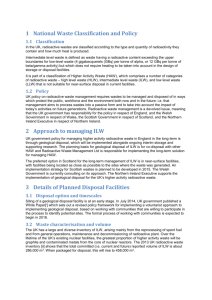Summary Note on Potential Impacts of Implementing Geological
advertisement
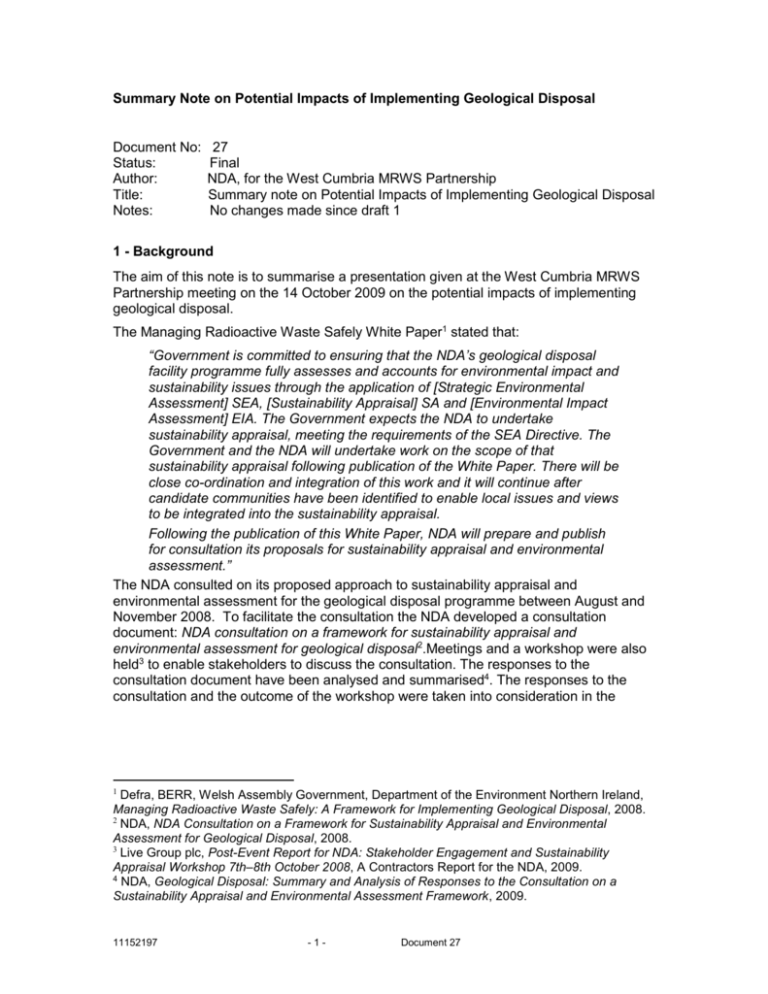
Summary Note on Potential Impacts of Implementing Geological Disposal Document No: Status: Author: Title: Notes: 27 Final NDA, for the West Cumbria MRWS Partnership Summary note on Potential Impacts of Implementing Geological Disposal No changes made since draft 1 1 - Background The aim of this note is to summarise a presentation given at the West Cumbria MRWS Partnership meeting on the 14 October 2009 on the potential impacts of implementing geological disposal. The Managing Radioactive Waste Safely White Paper1 stated that: “Government is committed to ensuring that the NDA’s geological disposal facility programme fully assesses and accounts for environmental impact and sustainability issues through the application of [Strategic Environmental Assessment] SEA, [Sustainability Appraisal] SA and [Environmental Impact Assessment] EIA. The Government expects the NDA to undertake sustainability appraisal, meeting the requirements of the SEA Directive. The Government and the NDA will undertake work on the scope of that sustainability appraisal following publication of the White Paper. There will be close co-ordination and integration of this work and it will continue after candidate communities have been identified to enable local issues and views to be integrated into the sustainability appraisal. Following the publication of this White Paper, NDA will prepare and publish for consultation its proposals for sustainability appraisal and environmental assessment.” The NDA consulted on its proposed approach to sustainability appraisal and environmental assessment for the geological disposal programme between August and November 2008. To facilitate the consultation the NDA developed a consultation document: NDA consultation on a framework for sustainability appraisal and environmental assessment for geological disposal2.Meetings and a workshop were also held3 to enable stakeholders to discuss the consultation. The responses to the consultation document have been analysed and summarised4. The responses to the consultation and the outcome of the workshop were taken into consideration in the 1 Defra, BERR, Welsh Assembly Government, Department of the Environment Northern Ireland, Managing Radioactive Waste Safely: A Framework for Implementing Geological Disposal, 2008. 2 NDA, NDA Consultation on a Framework for Sustainability Appraisal and Environmental Assessment for Geological Disposal, 2008. 3 Live Group plc, Post-Event Report for NDA: Stakeholder Engagement and Sustainability Appraisal Workshop 7th–8th October 2008, A Contractors Report for the NDA, 2009. 4 NDA, Geological Disposal: Summary and Analysis of Responses to the Consultation on a Sustainability Appraisal and Environmental Assessment Framework, 2009. 11152197 -1- Document 27 development of the NDA Strategy: Geological Disposal: A Strategy for Sustainability Appraisal and Environmental Assessment5. The European Directive on Strategic Environmental Assessment or SEA6 and the European Directive on the environmental assessment of projects7 amended by8 require the assessment of the potential social, economic and environmental impacts of implementing plans, programmes and projects. The Strategy sets out NDA’s approach to assessing social, environmental and economic impacts of implementing geological disposal. The NDA plans to undertake assessments of social, economic and environmental impacts using SEA and EIA following Government guidance and good practice. The NDA will engage stakeholders throughout the assessments and the assessments will be linked to the MRWS site assessment stages. The results of the assessments will be integrated into the design and implementation of the geological disposal facility. Figure 1 outlines when NDA plans to undertake the assessments in relation to the MRWS site assessment process. 2 - Previous Environmental Assessments There have been several assessments of the potential social, economic and environmental impacts of implementing geological disposal undertaken in other countries to determine the suitability of sites for hosting geological disposal facilities for the disposal of various types of radioactive waste. Countries with experience in this field include Canada, Sweden, Finland and the USA. Examples of work that has been undertaken overseas to assess the safety and environmental impacts of geological disposal facilities include: Posiva Oy, The Final Disposal Facility for Spent Nuclear Fuel Environmental Impact Assessment Report, May 1999; SKB (Svensk Kambranslehantering), Feasibility studies for siting of a deep repository within different municipalities, 1995, 1996, 2001; 5 NDA, Geological Disposal: A Strategy for Sustainability Appraisal and Environmental Assessment, 2009. 6 European Parliament and the Council of the European Union, “Directive 2001/42/EC of the European Parliament and of the Council of 27 June 2001 on the Assessment of the Effects of certain Plans and Programmes on the Environment”, Official Journal of the European Communities, L197, 2001. 7 Council of the European Communities, “Council Directive of 27 June 1985 on the Assessment of the Effects of Certain Public and Private Projects on the Environment (85/337/EEC)”, Official Journal of the European Communities, C175, 1985 amended by Council of the European Union, "Council Directive 97/11/EC of 3 March 1997 amending Directive 85/337/EEC on the assessment of the effects of certain public and private projects on the environment", Official Journal of the European Communities, 40(L73), pages 5-14, 1997. 8 European Parliament and the Council of the European Union, "Directive 2003/35/EC of the European Parliament and of the Council of 26 May 2003 providing for public participation in respect of the drawing up of certain plans and programmes relating to the environment and amending with regard to public participation and access to justice Council Directives 85/337/EEC and 96/61/EC", Official Journal of the European Communities, L156, pages 17-24, 2003. 11152197 -2- Document 27 Golder Associates, Independent assessment of long-term management options for low and intermediate level wastes at Ontario Power Generation’s Western Waste Management Facility, February 2004; Golder Associates, Western Waste Management Facility – Independent Economic and Social Analysis, 2004. Department of Energy, Environmental Impact Statement for a Geologic Depository for the Disposal of Spent Nuclear Fuel and High – Level Radioactive Waste at Yucca Mountain Nevada, February 2002 [NB. Supplementary Environmental Impact Assessment produced – 2007]. These assessments are specific to the waste, disposal facility and conditions at each particular site. However, they provide useful information about the potential environmental, social and economic effects of implementing geological disposal facilities. 11152197 -3- Document 27 MRWS Site Selection Stage Stage 1: Invitation issued and Expressions of Interest from Communities NDA consultation: Proposals for sustainability appraisal and environmental assessment Stage 2: Consistently applied ‘sub-surface unsuitability’ test NDA Generic Assessments of social, economic and environmental impacts of implementing geological disposal Stage 3: Community consideration leading to Decision to Participate Community Decision Strategic Environmental Assessment Candidate 1 NDA desk-based studies Candidate 2 NDA desk-based studies Candidate 3 NDA desk-based studies Candidate 4 NDA desk-based studies Stage 4: Desk-based studies on remaining candidates Environmental and Sustainability Report Local and national decision Environmental Impact Assessment Site 2 surface-based investigations Site 1 surface-based investigations Environmental Statement Stage 5: Surface investigations on remaining candidates Local and national decision Revised Environmental Statement Stage 6: Underground operations Figure 1: Overview of MRWS Assessments 11152197 -4- Document 27 In the UK Nirex and then the NDA have published a series of reports which assess the potential social, economic and environmental impacts of implementing geological disposal facility concepts for the UK’s higher activity radioactive wastes. The assessments consider generic (i.e. not site specific) geological disposal facility concepts that have been developed for the UK’s wastes: RPS, Non-Radiological Environmental Assessment of the Nirex Phased Geological Disposal Concept. Stage 1: Generic Concept Design Assessment. Assessment Report, A Report for Nirex, March 2007. RPS, Preliminary Generic Non-radiological Sustainability Appraisal of the High Level Waste and Spent Fuel Concept – Appraisal Report, A Report for the NDA, 2008. Entec UK Ltd, Sustainability Appraisal of Surface Based Investigations – Sustainability Appraisal Report, A Report for the NDA, 2008. 3 - Potential Impacts From the assessments outlined above it is possible to identify some of the potential impacts of implementing geological disposal facilities. The actual impacts of implementing a facility will depend on where the facility is located, the wastes being managed and the exact design of the disposal facility. These will be assessed at the appropriate stage in the MRWS programme. Potential effects may include: • Landscape and visual effects: changes to or loss of views from drilling rigs and surface facilities, traffic movements; • Land use: land will be required for boreholes, the disposal facility, infrastructure; • Cultural heritage: impacts on heritage sites, archaeological disturbance; • Geology and soils: effects on the host geology, soil quality; • Ecology and nature conservation: creation, disturbance or loss of habitat, impacts on wildlife from construction; • Traffic and transport: new infrastructure, increased traffic from transport of materials, personnel and waste • Air quality and climate: dust and emissions from transport and construction; • Noise and vibration: from construction and transport; • Water resources: changes in usage, discharges and water quality; • Community effects: employment, population, skill levels; • Health effects: risks from construction and operation of the facility and transport associated with it. 11152197 -5- Document 27 4 - Potential Mitigation Part of the SEA and EIA processes will include consideration of options to put in place measures to prevent, design out or mitigate adverse impacts, maximise positive impacts and monitor the effect of the NDA’s plans and programmes for geological disposal. It will be important to work with the potential host community to develop the mitigation measures and identify opportunities for maximising the positive impacts of implementing a geological disposal facility, for example job opportunities. Potential mitigation measures to address negative impacts could include: • Changes to the design of the facility; • Changes to the way the facility is implemented; • Using different materials to construct the facility; The physical design of the surface facilities will be particularly important and the NDA will work with the potential host community to ensure that it fits within the host environment and is acceptable to the host community. For example, in Sweden the surface facilities for the underground research facilities have been designed to look like farm buildings, so that they fit in with the local environment. The exact mitigation measures will be evaluated as part of the SEA and EIAs and will be developed in consultation with the local community, they will depend on the particular site being investigated. Another way that impacts can be minimised is through the mechanisms for appointing contractors to work on the facility. Sustainability issues will evaluated when considering tenders from contractors and contractors’ environmental and sustainability performance will be monitored. 5 - Summary The actual impacts of implementing a geological disposal facility will be depend on the site chosen, the wastes to be managed and the design of the disposal facility. NDA will assess the potential social, economic and environmental impacts in line with regulations and good practice at the appropriate stage in the MRWS site assessment process. Stakeholders will be involved throughout the assessments and the results of the assessments will be integrated into the design of the facility and its implementation. The assessment will include developing measures to prevent, design out or mitigate adverse impacts, maximise positive impacts and monitor the effect of the NDA’s plans and programmes for geological disposal. These will also depend on the site being considered. Any community hosting a GDF will expect Government and NDA to ensure that the project contributes to its development and well being. Sustainability issues will also be taken into account when appointing and monitoring contractors to ensure that they work in a sustainable way. 11152197 -6- Document 27
